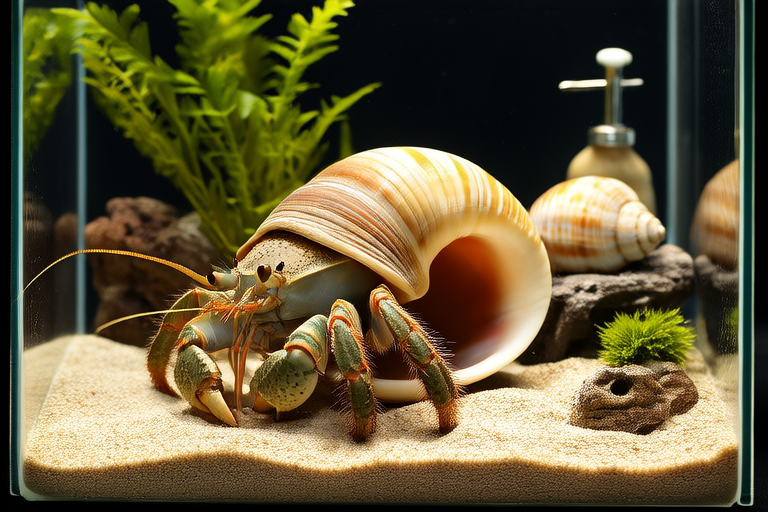Creating an Ideal Habitat for Shy Yet Social Hermit Crabs
Hermit crabs are fascinating creatures that require a unique balance of solitude and social interaction. These crustaceans are known for their shy nature but also possess a strong desire for social interaction. Creating an ideal habitat for these creatures involves understanding their needs and preferences while providing a safe and enriching environment. This article will guide you through setting up the perfect home for your hermit crabs, ensuring they thrive both physically and socially.
Essential Tank Setup
The first step in creating an ideal habitat is selecting an appropriate tank. Hermit crabs need enough space to move around comfortably, so choose a tank that is at least ten gallons for a small group. A larger tank will allow for more substrate depth and additional hiding spots, which are crucial for shy hermit crabs. Ensure the tank has a secure lid with ventilation holes to prevent escapes while allowing air circulation.
In addition to the tank, you’ll need a variety of decorations and accessories. Provide ample hiding spots using coconut huts, cork bark, or driftwood. These items offer shelter and security, helping to reduce stress levels among your hermit crabs. Include climbing structures such as branches or rocks to encourage physical activity and exploration. Place these items strategically throughout the tank to create multiple levels within the enclosure.
Temperature and Humidity Requirements
Maintaining the correct temperature and humidity levels is vital for hermit crab health. The ideal temperature range for hermit crabs is between 75°F and 85°F (24°C to 29°C). Use a thermometer to monitor the temperature inside the tank, and if necessary, install a heat lamp or under-tank heater to maintain this range. Avoid placing the tank near direct sunlight or drafts, as extreme temperatures can be harmful.
Humidity levels should be kept between 70% and 80%. Low humidity can cause respiratory issues, while high humidity may lead to mold growth. To achieve optimal humidity, mist the tank daily using a spray bottle filled with dechlorinated water. Alternatively, you can use a humidifier specifically designed for reptile enclosures. Monitor the humidity level with a hygrometer placed inside the tank.
Suitable Substrate Options
Selecting the right substrate is essential for hermit crabs, as it provides a place to dig, burrow, and find food. Suitable substrates include a mixture of coconut fiber, sand, and calcium carbonate. The substrate should be deep enough to allow digging and burrowing, typically around four inches deep. Ensure the substrate is free from harmful chemicals or additives that could be toxic to your hermit crabs.
It’s important to avoid using fine sand or any substrate that could potentially clog their gills or cause impaction if ingested. Additionally, provide various shell sizes for your hermit crabs to explore and potentially molt into new shells. Clean the substrate regularly to prevent bacterial growth and ensure a healthy environment.
Enrichment Items for Their Social Behavior
Hermit crabs are naturally curious and enjoy exploring their surroundings. Providing enrichment items encourages social interaction and mental stimulation. Introduce toys such as plastic tunnels, bridges, or even small pieces of PVC pipe. These items can be rearranged periodically to keep the environment fresh and exciting.
Foraging opportunities are also beneficial. Hide treats like dried fish, algae wafers, or commercial hermit crab food within the substrate or scattered around the tank. This encourages natural foraging behaviors and promotes social interactions as hermit crabs search for food together. Rotate these items regularly to prevent boredom and encourage continued engagement.
Proper Lighting Conditions
Hermit crabs do not require UVB lighting but benefit from a consistent light cycle to regulate their circadian rhythms. Provide 12 hours of light followed by 12 hours of darkness each day. Use a low-wattage incandescent bulb or LED light fixture designed for reptiles. Position the light source above the tank but out of reach to prevent overheating.
Avoid using lights that produce excessive heat, as this could disrupt the temperature control within the tank. If you’re concerned about the light affecting the humidity levels, consider using a timer to automate the light cycle and ensure consistency.
Tips for Maintaining a Healthy Environment
To maintain a healthy environment for your hermit crabs, regular maintenance is key. Perform weekly water changes in any water dishes provided, ensuring the water remains clean and free from contaminants. Check the substrate for signs of mold or bacteria and replace it as needed. Clean any decorations or accessories with a mild bleach solution, rinsing thoroughly before returning them to the tank.
Monitor the overall health of your hermit crabs by observing their behavior and appearance. Look for signs of illness such as lethargy, loss of appetite, or discoloration. If you notice any concerning symptoms, consult a veterinarian specializing in exotic animals for advice.
Finally, ensure your hermit crabs have access to fresh water and saltwater. Provide separate dishes for each, ensuring the saltwater is made with marine-grade aquarium salt and properly mixed according to the package instructions. Regularly check the water quality and change it as needed to maintain cleanliness.
Understanding Their Balance Between Shyness and Social Needs
Understanding the balance between shyness and social needs is crucial for optimal care. While hermit crabs are naturally shy, they still require social interaction to thrive. Observe your hermit crabs’ behavior closely to determine their comfort levels with each other. Some hermit crabs may prefer solitary time, while others may actively seek out companionship.
Provide a mix of solitary and communal spaces within the tank. Ensure there are enough hiding spots for each crab to retreat to when feeling overwhelmed. Encourage social interactions during feeding times or enrichment activities, but respect individual boundaries. By striking the right balance, you’ll create an environment where your hermit crabs can flourish both individually and collectively.
